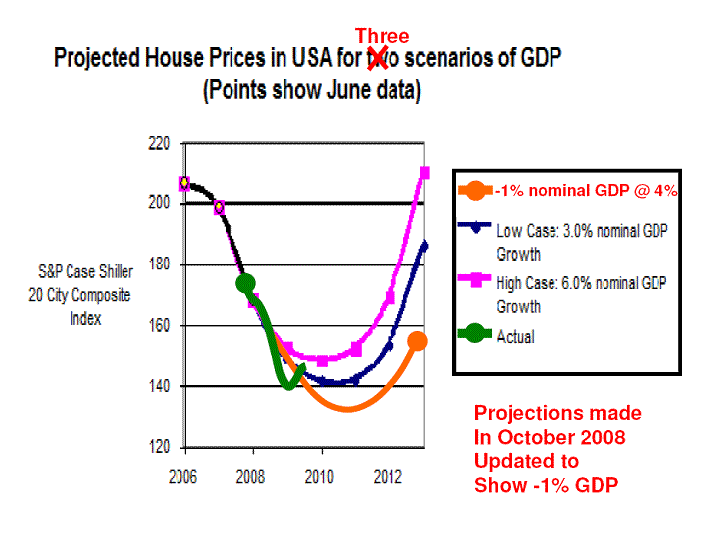BubbleOmics, Reflecting On My 2008 U.S. House Price Prediction
Housing-Market / US Housing Feb 24, 2010 - 12:41 AM GMTBy: Andrew_Butter
 What worries me about what is increasingly looking like a bottom and bounce in US prices is mainly that it’s too soon.
What worries me about what is increasingly looking like a bottom and bounce in US prices is mainly that it’s too soon.
Bubbles are about mal-investment; normally created by credit under one guise or another. That’s how the South Sea Bubble got going, same thing for 1929, Dot.com and housing; people start paying a price because they can get credit (and they think prices are going up), rather than weighing their needs against their means. Fear plays a part too, fear of missing the boat and “never being able to own a house”, you can’t blame people for that.
The way it normally works is that the mal-investments have got to get cleaned out before the market can return to normal, and that normally takes about as much time as it took for the mal-investments to be created.
According to me the US housing bubble started in about 2001 and ended in about 2007 (that’s when the “equilibrium” was crossed), so that means about 2013 before the equilibrium is found again, according to me.
Where that will end up will depend on the progression of nominal GDP per housing unit (a linear relationship) and long-term Treasury yields (an “S” curve).
This a chart I put out in early October 2008 based on something I worked out in June 2008 and put out in September.

http://www.marketoracle.co.uk/Article6668.html
The green line is what happened, the orange line is a re-work of where I was then (I hadn’t anticipated that nominal GDP would fall of a cliff (I’m not an economist, although to be fair, a lot of economists hadn’t anticipated that either)).
So perhaps I was being alarmist, maybe its back to the drawing board, perhaps governments can find a way to ease the pain of mal-investment re-adjusting.
I have two points there; the first is that there are a lot of foreclosing and potentially foreclosing properties out there. That’s not a sign of a bottom, even if the government is helping lenders to tide themselves over.
I estimated six months ago that by the time this is all over there will have been as many as six million American families kicked out of their homes, with all the tragedy that entails – if you figure three per house as an average that’s about 18 million people that will have gone through that trauma; and it’s not even half-way there.
But these days I’m not the only person talking about numbers like that.
The second thing is that I get the sneaky feeling that all the “programs” have had some effect, which is all very well.
But I also have the sinking feeling that’s just a way if putting off the pain and that the money would have been better spent helping the families directly, many of whom understood less about the awful situation they put themselves in than the people who were supposed to know better; because there is an inevitability; like the tide.
And in that context, I think that trying to hold back the tide is often counter-productive, it puts money in places where in the end it will turn out to have been a waste, just a way of putting off suffering. I think that’s what happened after the Dot.com; there economic policy was designed to alleviate pain, not fix the problem; and sometimes that just makes things worse in the end.
I hope I’m wrong, and on that note, it’s worth remarking; I’ve been wrong before.
On a positive note, lenders need to understand that now is a good time to start writing those 100% LTV loans they were so fond of in 2005 and 2006, because even if it goes down again, it’s not going down a lot, unless nominal GDP starts to go down at lot.
By Andrew Butter
Twenty years doing market analysis and valuations for investors in the Middle East, USA, and Europe; currently writing a book about BubbleOmics. Andrew Butter is managing partner of ABMC, an investment advisory firm, based in Dubai ( hbutter@eim.ae ), that he setup in 1999, and is has been involved advising on large scale real estate investments, mainly in Dubai.
© 2010 Copyright Andrew Butter- All Rights Reserved
Disclaimer: The above is a matter of opinion provided for general information purposes only and is not intended as investment advice. Information and analysis above are derived from sources and utilising methods believed to be reliable, but we cannot accept responsibility for any losses you may incur as a result of this analysis. Individuals should consult with their personal financial advisors.
Andrew Butter Archive |
© 2005-2022 http://www.MarketOracle.co.uk - The Market Oracle is a FREE Daily Financial Markets Analysis & Forecasting online publication.



